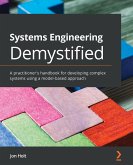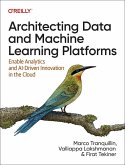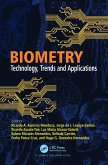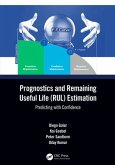Mark W. Maier (Centreville, VA, USA), Eberhardt Rechtin (University of Southern California, Palos Verdes,
The Art of Systems Architecting
Mark W. Maier (Centreville, VA, USA), Eberhardt Rechtin (University of Southern California, Palos Verdes,
The Art of Systems Architecting
- Gebundenes Buch
- Merkliste
- Auf die Merkliste
- Bewerten Bewerten
- Teilen
- Produkt teilen
- Produkterinnerung
- Produkterinnerung
This new edition provides structured heuristics to improve the least structured, most art-like elements of systems design. It offers unique techniques to bridge the difference between scientific engineering and qualitative design along with comprehensive methods for combining architectural design with digital engineering.
Andere Kunden interessierten sich auch für
![Systems Engineering Demystified Systems Engineering Demystified]() Jon HoltSystems Engineering Demystified55,99 €
Jon HoltSystems Engineering Demystified55,99 €![Architecting Data and Machine Learning Platforms Architecting Data and Machine Learning Platforms]() Marco TranquillinArchitecting Data and Machine Learning Platforms46,99 €
Marco TranquillinArchitecting Data and Machine Learning Platforms46,99 €![Artificial Intelligence and Playable Media Artificial Intelligence and Playable Media]() Eric Freedman (USA Columbia College Chicago)Artificial Intelligence and Playable Media167,99 €
Eric Freedman (USA Columbia College Chicago)Artificial Intelligence and Playable Media167,99 €![What Every Engineer Should Know About Smart Cities What Every Engineer Should Know About Smart Cities]() Valdemar Vicente Graciano NetoWhat Every Engineer Should Know About Smart Cities62,99 €
Valdemar Vicente Graciano NetoWhat Every Engineer Should Know About Smart Cities62,99 €![Biometry Biometry]() Biometry182,99 €
Biometry182,99 €![Digital Twins Digital Twins]() Nilmini WickramasingheDigital Twins64,99 €
Nilmini WickramasingheDigital Twins64,99 €![Prognostics and Remaining Useful Life (RUL) Estimation Prognostics and Remaining Useful Life (RUL) Estimation]() Diego Galar (Sweden Lulea University of Technology)Prognostics and Remaining Useful Life (RUL) Estimation214,99 €
Diego Galar (Sweden Lulea University of Technology)Prognostics and Remaining Useful Life (RUL) Estimation214,99 €-
-
-
This new edition provides structured heuristics to improve the least structured, most art-like elements of systems design. It offers unique techniques to bridge the difference between scientific engineering and qualitative design along with comprehensive methods for combining architectural design with digital engineering.
Produktdetails
- Produktdetails
- Verlag: Taylor & Francis Ltd
- 4 ed
- Seitenzahl: 520
- Erscheinungstermin: 5. Juni 2025
- Englisch
- Abmessung: 240mm x 161mm x 32mm
- Gewicht: 874g
- ISBN-13: 9781032774381
- ISBN-10: 103277438X
- Artikelnr.: 72487465
- Herstellerkennzeichnung
- Libri GmbH
- Europaallee 1
- 36244 Bad Hersfeld
- gpsr@libri.de
- Verlag: Taylor & Francis Ltd
- 4 ed
- Seitenzahl: 520
- Erscheinungstermin: 5. Juni 2025
- Englisch
- Abmessung: 240mm x 161mm x 32mm
- Gewicht: 874g
- ISBN-13: 9781032774381
- ISBN-10: 103277438X
- Artikelnr.: 72487465
- Herstellerkennzeichnung
- Libri GmbH
- Europaallee 1
- 36244 Bad Hersfeld
- gpsr@libri.de
Dr. Mark W. Maier is a technical fellow at The Aerospace Corporation, Electronics and Sensors Division, an architect¿engineering firm specializing in space systems for the United States Government. His specialty is systems architecture. He teaches and consults in that subject for The Aerospace Corporation, its clients, and corporations throughout the United States and Europe. He has done pioneering work in the field, especially in collaborative systems, sociötechnical systems, and modeling, as well as significant research in advanced sensors. He is a senior member of the IEEE and one of the lead authors of ANSI/IEEE 1471 Recommended Practice for Architecture Description, which has become the basis for further international standardization. Dr. Maier received his B.S. degree in Engineering and Applied Science and an M.S. in Electrical Engineering from Caltech in 1983 and 1984, respectively. He joined the Hughes Aircraft Company in El Segundo, CA, upon graduating from Caltech in 1983. At Hughes, he was a section head responsible for signal processing algorithm design and systems engineering. While at Hughes, he was awarded a Howard Hughes Doctoral Fellowship, on which he completed a Ph.D. in Electrical Engineering, specializing in radar signal processing, at USC. At USC, he began his collaboration with Dr. Eberhardt Rechtin, who started the first systems architecture academic program. In 1992, he joined the faculty of the University of Alabama in Huntsville in the Electrical and Computer Engineering Department. As an associate professor at UAH, he carried out research in system architecture, stereo image compression, and radar signal processing. He has published several dozen journal articles and conference papers in these fields. Dr. Eberhardt Rechtin received his B.S. and Ph.D. degrees from the California Institute of Technology (Caltech) in 1946 and 1950, respectively. He joined Caltech's Jet Propulsion Laboratory (JPL) in 1948 as an engineer, leaving it in 1967 as assistant director. At JPL, he was the chief architect and director of the NASA/JPL Deep Space Network. In 1967, he joined the Office of the Secretary of Defense as the director of the Advanced Research Projects Agency (ARPA) and later as assistant secretary of defense for Telecommunications. He left the Department of Defense in 1973 to become chief engineer of Hewlett¿Packard. He was elected as the president and CEO of The Aerospace Corporation in 1977, retiring in 1987. After retirement from Aerospace, he joined the faculty of the University of Southern California (USC) as a professor with joint appointments in Electrical Engineering¿ystems, Industrial & Systems Engineering, and Aerospace Engineering. During his time at USC, he founded their graduate program in Systems Architecting. Dr. Rechtin was extensively honored for his engineering accomplishments. He was a member of the National Academy of Engineering; a fellow of the IEEE, AIAA, and the AAAS; and an Academician of the International Academy of Astronautics. He was further honored by the IEEE with its Alexander Graham Bell Award, by the Department of Defense with the Distinguished Public Service Award, by NASA with its Medal for Exceptional Scientific Achievement, by the AIAA with its von Karman Lectureship, by Caltech with its Distinguished Alumni award, and by NEC with its C&C Prize. His published works include Systems Architecting: Creating and Building Complex Systems, Prentice Hall, 1991; The Art of Systems Architecting with Mark W. Maier; and Why Eagles Can't Swim: The Systems Architecting of Organizations. Dr. Rechtin passed away in 2006.
Part I: Introduction. 0.1. Case Study 1: The DARPA Grand Challenge. 1.
Extending the Architecting Paradigm. 2. Heuristics as Tools. Part II:
Introduction: New Domains, New Insights. 0.2. Case Study 2: The DC-3. 3.
Builder-Architected Systems. 0.3. Case Study 3: Mass and Lean Production.
4. Manufacturing Systems. 0.4. Case Study 4: Intelligent Transportation
Systems. 5. Social Systems. 0.5. Case Study 5: MedInfo and Layered Systems.
6. Software and Information Technology Architecture. 0.6. Case Study 6: The
Global Positioning System. 7. Collaborative Systems. Part III:
Introduction: Processes and Models. 0.7. Case Study 7: SAR Drone. 8.
Architecting Models and Processes Concepts. 9. A General Architecting
Process. 10. Architecting with Digital Engineering. 11. Frameworks and
Standards. Part IV: Introduction: The Systems Architecting Profession. 12.
Architecting in Business and Government. 13. The Political Process and
Systems Architecting. 14. The Professionalization of Systems Architecting.
Appendix A. Appendix B. Appendix C. Glossary.
Extending the Architecting Paradigm. 2. Heuristics as Tools. Part II:
Introduction: New Domains, New Insights. 0.2. Case Study 2: The DC-3. 3.
Builder-Architected Systems. 0.3. Case Study 3: Mass and Lean Production.
4. Manufacturing Systems. 0.4. Case Study 4: Intelligent Transportation
Systems. 5. Social Systems. 0.5. Case Study 5: MedInfo and Layered Systems.
6. Software and Information Technology Architecture. 0.6. Case Study 6: The
Global Positioning System. 7. Collaborative Systems. Part III:
Introduction: Processes and Models. 0.7. Case Study 7: SAR Drone. 8.
Architecting Models and Processes Concepts. 9. A General Architecting
Process. 10. Architecting with Digital Engineering. 11. Frameworks and
Standards. Part IV: Introduction: The Systems Architecting Profession. 12.
Architecting in Business and Government. 13. The Political Process and
Systems Architecting. 14. The Professionalization of Systems Architecting.
Appendix A. Appendix B. Appendix C. Glossary.
Part I: Introduction. 0.1. Case Study 1: The DARPA Grand Challenge. 1.
Extending the Architecting Paradigm. 2. Heuristics as Tools. Part II:
Introduction: New Domains, New Insights. 0.2. Case Study 2: The DC-3. 3.
Builder-Architected Systems. 0.3. Case Study 3: Mass and Lean Production.
4. Manufacturing Systems. 0.4. Case Study 4: Intelligent Transportation
Systems. 5. Social Systems. 0.5. Case Study 5: MedInfo and Layered Systems.
6. Software and Information Technology Architecture. 0.6. Case Study 6: The
Global Positioning System. 7. Collaborative Systems. Part III:
Introduction: Processes and Models. 0.7. Case Study 7: SAR Drone. 8.
Architecting Models and Processes Concepts. 9. A General Architecting
Process. 10. Architecting with Digital Engineering. 11. Frameworks and
Standards. Part IV: Introduction: The Systems Architecting Profession. 12.
Architecting in Business and Government. 13. The Political Process and
Systems Architecting. 14. The Professionalization of Systems Architecting.
Appendix A. Appendix B. Appendix C. Glossary.
Extending the Architecting Paradigm. 2. Heuristics as Tools. Part II:
Introduction: New Domains, New Insights. 0.2. Case Study 2: The DC-3. 3.
Builder-Architected Systems. 0.3. Case Study 3: Mass and Lean Production.
4. Manufacturing Systems. 0.4. Case Study 4: Intelligent Transportation
Systems. 5. Social Systems. 0.5. Case Study 5: MedInfo and Layered Systems.
6. Software and Information Technology Architecture. 0.6. Case Study 6: The
Global Positioning System. 7. Collaborative Systems. Part III:
Introduction: Processes and Models. 0.7. Case Study 7: SAR Drone. 8.
Architecting Models and Processes Concepts. 9. A General Architecting
Process. 10. Architecting with Digital Engineering. 11. Frameworks and
Standards. Part IV: Introduction: The Systems Architecting Profession. 12.
Architecting in Business and Government. 13. The Political Process and
Systems Architecting. 14. The Professionalization of Systems Architecting.
Appendix A. Appendix B. Appendix C. Glossary.








